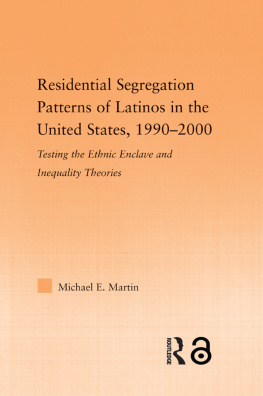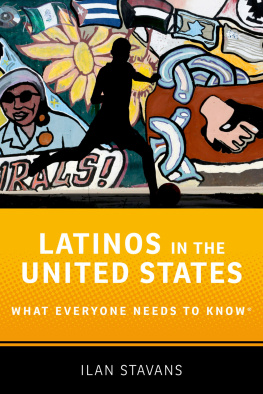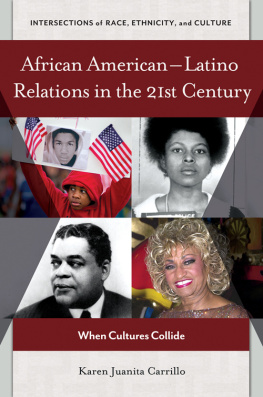LATINO COMMUNITIES EMERGING VOICES
POLITICAL, SOCIAL, CULTURAL AND LEGAL ISSUES
Edited by
Antoinette Sedillo Lopez
University of New Mexico
A ROUTLEDGE SERIES
LATINO COMMUNITIES: EMERGING VOICES
POLITICAL, SOCIAL, CULTURAL, AND LEGAL ISSUES
ANTOINETTE SEDILLO LOPEZ, General Editor
LATINOS IN ETHNIC ENCLAVES
Immigrant Workers and the Competitionfor Jobs
Stephanie Bohon
TELLING OUR STORIES
The Lives of Midwestern Latinas
Theresa Barron McKeagney
DOMINICANS IN NEW YORK CITY
Power From the Margins Milagros Ricourt
LATINO NATIONAL POLITIAL COALITIONS
Struggles and Challenges David Rodriguez
CREATING TROPICAL YANKEES
Social Science Textbooks and U.S.
Ideological Control in Puerto Rico,18981908
Jos-Manuel Navarro
BROWN EYES ON THE WEB
Unique Perspectives of an Alternative
U.S. Latino Online Newspaper
Maggie Rivas-Rodriguez
PREGONES THEATRE
A Theatre for Social Change in theSouth Bronx
Eva C. Vsquez
THE QUEST FOR TEJANO IDENTITY IN SAN ANTONIO, TEXAS, 19132000
Richard A. Buitron, Jr.
CARIBBEAN SPANISH IN THE METROPOLIS
Spanish Language among Cubans,
Dominicans, and Puerto Ricans in theNew York City Area
Edwin M. Lamboy
SKIN COLOR AND IDENTITY FORMATION
Perceptions of Opportunity andAcademic Orientation among Mexicanand Puerto Rican Youth
Edward Fergus
INVITING LATINO VOTERS
Party Messages and Latino Party
Identification
Stacey L. Connaughton
LEAVING LATINOS OUT OF HISTORY
Teaching U.S. History in Texas
Julio Noboa
GAY HEGEMONY/LATINO HOMOSEXUALITIES
Manolo Guzmn
LATINO-ANGLO BARGAINING
Culture, Structure, and Choice inCourt Mediation
Christine Rack
THE PROMISED LAND?
The Lives and Voices of Hispanic
Immigrants in the New South
Patricia L. Goerman
POST-REVOLUTIONARY CHICANA LITERATURE
Memoir, Folklore, and Fiction of theBorder, 19001950
Sam Lpez
RESIDENTIAL SEGREGATION PATTERNS OF LATINOS IN THE UNITED STATES, 19902000
Testing the Ethnic Enclave and
Inequality Theories
Michael E. Martin
RESIDENTIAL SEGREGATION PATTERNS OF LATINOS IN THE UNITED STATES, 19902000
Testing the Ethnic Enclave and Inequality Theories
Michael E. Martin
First published 2007 by Routledge
Published 2017 by Routledge
2 Park Square, Milton Park, Abingdon, Oxon OX14 4RN 711 Third Avenue, New York, NY 10017, USA
First issued in paperback 2014
Routledge is an imprint of the Taylor and Francis Group, an informa business
Copyright 2007 Taylor & Francis
ISBN 13: 978-0-415-97903-0 (hbk)
ISBN 13: 978-0-415-54206-7 (pbk)
The Open Access version of this book, available at www.tandfebooks.com, has been made available under a Creative Commons Attribution-Non Commercial-No Derivatives 4.0 license.
Library of Congress Cataloging-in-Publication Data
Martin, Michael E., Ph. D.
Residential segregation patterns of Latinos in the United States, 1990-2000 : testing the ethnic enclave and inequality theories / by Michael E. Martin.
p. cm. -- (Latino communities)
Includes bibliographical references and index.
ISBN 0-415-97903-X (alk. paper)
1. 1. Discrimination in housing--United States. 2. Ethnic neighborhoods--United States. 3. Hispanic AmericansCultural assimilation. 4. Equality--United States. I. Title. II. Series.
HD7288.76.U5M37 2006
363.51--dc22
2006016127
Visit the Taylor & Francis Web site at
http://www.taylorandfrancis.com
and the Routledge Web site at
http://www.routledge-ny.com
List of Maps & Figures
MAPS
Latino Residential Segregation in 2000
Change in Segregation 19902000
Puerto Rican Residential Segregation in 2000
Mexican Residential Segregation in 2000
Cuban Residential Segregation in 2000
Los Angeles-Long Beach, CA MSA
New York, NY MSA
Miami, FL MSA
Orlando, FL MSA
FIGURES
Segregation Rates (D) Scores 19702000 for Black/Anglo and Latino/Anglo
List of Tables
Non-White Persons Living in Highly Segregated Metropolitan Areas*
Disaggregated Latino Sub-Groups Living in Highly Segregated Metropolitan Areas in 2000
Regression Model: Demographic Variables and Latino/Anglo Segregation in 2000
Regression Model: Socio-Economic Variables and Latino/Anglo Segregation in 2000
Regression Model: Demographic & Socio-Economic Variables and Latino/Anglo Segregation
Regression Model-Demographic Variables and Latino/Anglo Segregation Increases 19902000
Regression Model-Socio-Economic Variables and Latino/Anglo Segregation Increases 19902000
Regression Model-Demographic & Socio-Economic Variables and Latino/Anglo Segregation Increases 19902000
Regression Model-Demographic Variables and Puerto Rican/Anglo Segregation in 2000
Regression Model-Demographic Variables and Mexican/Anglo Segregation in 2000
Regression Model-Demographic Variables and Cuban/Anglo Segregation in 2000
Regression Model-Socio-Economic Variables and Puerto Rican/ Anglo Segregation in 2000
Regression Model-Socio-Economic Variables and Mexican/Anglo Segregation in 2000
Regression Model-Socio-Economic Variables and Cuban/Anglo Segregation in 2000
Regression Model: Demographic & Socio-Economic Variables and Puerto Rican/Anglo Segregation
Regression Model: Demographic & Socio-Economic Variables and Mexican/Anglo Segregation
Regression Model: Demographic & Socio-Economic Variables and Cuban/Anglo Segregation
Chapter One
Introduction
This book will examine how Latino barrios are developing in the United States. The word barrio represents different things to different people. The barrio is a place where Latino culture thrives, where one can eat authentic Puerto Rican chuletas and tostones or hear a Cuban orquestra while sipping a cup of Cuban coffee. The barrio is a place where a Mexican immigrant can get job and find a place to live without speaking English. Spanish is spoken on the street, in stores and restaurants, to offer Anglos the opportunity to experience Latino culture. The barrio is a place where Latino immigrants can find cultural and linguistic comfort and refuge from the new and sometimes unhospitable majority Anglo culture.
The barrio also represents a place of inherent inequality, a place where Latino children are offered sub-standard education in segregated public schools. The barrio is a place where employment opportunities rarely offer a job with a family-supporting wage. A place abandoned by Anglo businesses because the neighborhood isnt what it used to be. The barrio is a place where banks change higher interest rates if you choose to live there and real estate values will never raise high enough to allow its residents to move beyond a starter home. The barrio is a place that causes Anglos to lock their car doors as they drive across town simply because they hear loud banda music coming from the car next to them at a stoplight.








